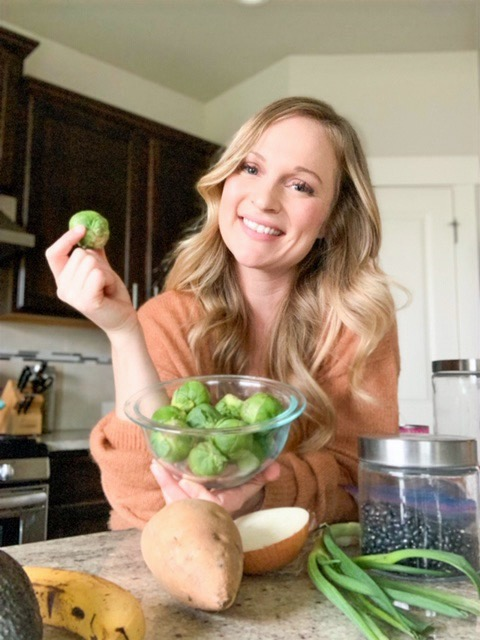8 Foods + Meal Ideas to Up Your Prebiotics
January 14, 2020

Click the picture for the video or continue reading for the transcript.
Today we’re talking prebiotics!
People tell me sometimes, “I want to support my gut, I take a probiotic but I’m not into sauerkraut, I don’t like kimchi, so what do I do?”
You can still support your gut by getting in lots of prebiotics.
What are prebiotics?
Prebiotics are a little bit different than probiotics. When you consume prebiotics, they help the probiotic bacteria grow. They’re kind of like the fertilizer of your gut, whatever probiotic bacteria you have in there, prebiotics come in and help the probiotic bacteria flourish.
How do I get in prebiotics?
Eat lots of fiber! Today I’m going to share with you eight foods that are high-prebiotic foods, high in fiber, and how you can incorporate them into your diet.
Prebiotic Rich Food
- Oats. Oats are full of fiber, are so easy to integrate into your routine, and are a great breakfast option. You want the old fashion rolled oats. You don’t want the oaks that come in a package with lot’s of sugar that you throw in the microwave with water and in a minute are ready. You want real, rolled oats. I have a great overnight oats recipe under the breakfast tab. You can also throw them in your smoothie or make a big batch at the beginning of the week and have it throughout the week for breakfast. Start incorporating oats into your diet!
- Avocado. I’m sure you know how to use an avocado and what it’s good with. My favorite things to do with avocados are to top it on a roasted sweet potato, have it as a topping on soup (it makes any soup a little bit better), and in smoothies! It’s a dairy-free alternative that make smoothies nice and creamy. 13 grams of fiber in one avocado! You want to get at least 25 grams of fiber if you’re a woman a day, 30 if you’re a man, at a minimum. With avocados you’re already over halfway there!
- Bananas. Bananas are such a humble little fruit but I think that they are so good for you in so many ways. They’re loaded with fiber, high in prebiotics. Mash them up in your overnight oats, add them as a sweetener in a smoothie, or chunk them up and freeze them, then blend them at night for a little plant-based ice cream. With bananas, the opportunities or endless.
- Cruciferous Veggies. Broccoli, cauliflower, cabbage, kale, and Brussels sprouts- all those really pungent veggies are called cruciferous veggies. They have lots of fiber and prebiotic bacteria. I love to shred my brussel sprouts and mix them up with some thinly sliced apples, top them with cheese and toasted almonds, and throw on a honey mustard dressing for a delicious salad. Or roasting any of these cruciferous veggies add so much flavor to any meal.
- Sweet Potatoes. Another high fiber, prebiotic food are sweet potatoes. When you cook sweet potatoes, keep the skin on because that ups the fiber content. Include sweet potatoes into your routine by baking them and then loading them with you favorite toppings. They are also great in soups, and possibly my favorite way of eating them is in enchiladas. I have a sweet potato and black bean enchilada recipe on the blog that is a family favorite, so give it a try! If you’re somebody that always feels like you want something sweet after dinner, add sweet potato to your routine and your sweet tooth might go away.
- Alliums. Alliums are the plants that add flavor to our dishes. Onions, garlic, and shallots are all examples of alliums and are really good at increasing the amount of prebiotic bacteria in your digestive system, especially when eaten raw. Chop up green onions and sprinkle them on top of soups or a bowl of chili. Onion or garlic goes great in a homemade dressing and is really good for you. I think we all probably cook a bit with onions and garlic, but getting it in raw occasionally is really helpful for the gut.
- Berries. All berries are great for increasing fiber consumption. Raspberries have 8 grams of fiber in one cup, so throw that in your morning smoothie or top your overnight oats with berries, and you will be upping your fiber content.
- Beans and Lentils. Beans and lentils are an easy way to get your daily dose of fiber in. Red lentils can be cooked in as little as 10 minutes, other beans take a bit longer. Cooking your own beans or buying canned beans are both great options. A half a cup of black beans has 5 grams of fiber, such a good way to get your fiber intake up throughout the day. I love putting them in my soup, often using white beans in many of my soups and then blending it, making it nice and creamy without any dairy. Other options are enchiladas, burrito bowls, or topping your salad with them.
There they are! The eight ingredients that you can add to your routine to get in your 25 grams of fiber a day: oats, avocados, bananas, cruciferous veggies, sweet potatoes, alliums, berries, and lentils/beans. I hope you guys are getting in your 25 grams per day. That is the best way to support your gut health through food, so make sure you’re getting your fiber in and including lots and lots of plants in your diet.
Take a look through my recipes to find loads of fiber rich meals you can make quickly and taste delicious!